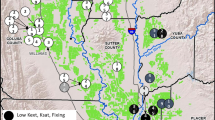Summary
This experiment examined the feasibility of predicting K uptake in white clover by the use of simple and relatively rapid tests that would dispense with the need of knowing the quantity of plant available potassium. Potassium uptake was found to correlate highly (R=>0.9) in linear bivariate regressions using K concentration in the soil solution displaced by centrifuging and an empirical estimate of potassium retention. There was no advantage in determining activity ratios because in at least some of the soils used the ratio law did not apply. Exchangeable potassium alone correlated rather poorly with uptake except at very low soil potassium status. This was not because nonexchangeable potassium was an important source of this nutrient to white clover but because of the large differences in the retention of K amongst the soils used.
Similar content being viewed by others
References
Barrow, N. J. 1966 Nutrient potential and capacity, II Relationship between potassium potential and buffering capacity and the supply of potassium to plants. Aust. J. Agric. Res.17, 849–861.
Beckett, P. H. T. 1964. Studies on soil potassium, I. Confirmation of the ratio law: Measurement of potassium potential. J. Soil Sci.15, 1–8.
During, C. 1973 The effective relative affinity for magnesium and potassium of some soils from the North Island, New Zealand. N.Z. J. Agric. Res.16, 1–8.
During, C. 1973 Cation exchange capacity at field pH and its relation to affinity of soils for individual cations. N.Z.J. Agric. Res.16, 9–23 (1973)
Fieldes, M. 1968 Clay mineralogy, pp 23–26.In Soils of New Zealand, N.Z. Soil Bur. Bull.26, (1968)
Martin, A. E. and Fergus, I. F. 1973 Studies on soil potassium. III. The intensity of soil potassium following exhaustion by different plants. Aust. J. Soil Res.11, 209–220.
Moss, P. 1969 A comparison of potassium activity ratios derived from equilibration procedures and from measurements on displaced soil solutions. J. Soil Sci.20, 297–306.
New Zealand Soil Bureau, DSIR 1953 General survey of the soils of North Island, Bull. (NS)5.
Ross, P. J., Fergus, I. F. and Martin, A. E. 1972 Studies on soil potassium I A theoretical model of Q/I relationships. Aust. J. Soil Res.10, 81–93.
Author information
Authors and Affiliations
Rights and permissions
About this article
Cite this article
During, C., Duganzich, D.M. Simple empirical intensity and buffering capacity measurements to predict potassium uptake by white clover. Plant Soil 51, 167–176 (1979). https://doi.org/10.1007/BF02232880
Received:
Issue Date:
DOI: https://doi.org/10.1007/BF02232880



